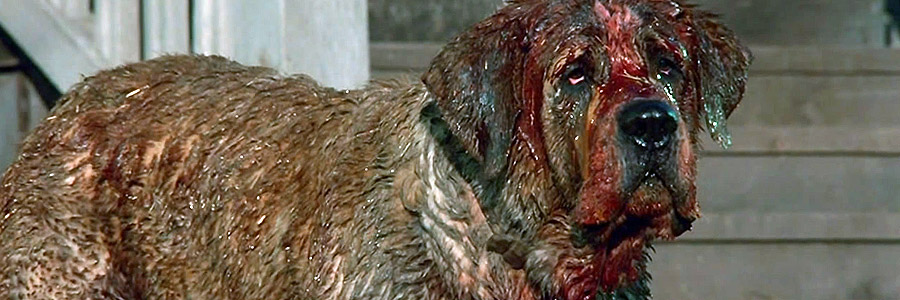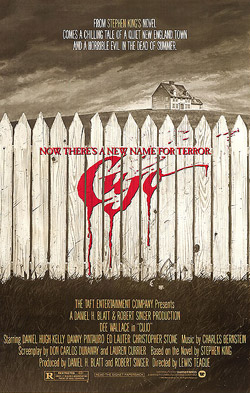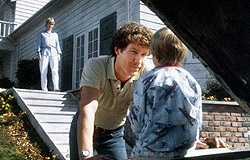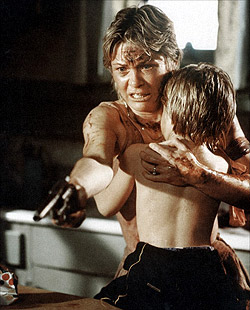
Cujo

CUJO (MOVIE)
Columbia Pictures
Original release: November 18th, 1983
Certificate: 18
Running time: 93 minutes
Director: Lewis Teague
Writers: Don Carlos Dunaway, Lauren Currier, Stephen King (novel)
Composer: Charles Bernstein
Man’s best friend. Who doesn’t love dogs? They’re loyal, welcoming and provide us with a love which no other household pet can. I class my dog Sasha as a member of the family. I believe she listens to my problems, tilting her head as if she understands me.
Now imagine if the dog you love changed from a loveable canine into a rabid, bloodthirsty killing machine. Beethoven this is not, it’s Lewis Teague’s 1983 cult classic Cujo.
Based on the 1981 Stephen King novel of the same name, Cujo begins with the dog in question, a St. Bernard, being infected with rabies after being bitten by a wild bat whilst chasing a rabbit in the woods. Meanwhile, Donna Trenton (Dee Wallace) is a frustrated housewife whose marriage is shattered when her husband Vic discovers she’s been having an affair. As he leaves town to get some space, Donna and her son Tad (Danny Pintauro) set off on a journey to Connecticut, however, on the way the car breaks down outside the Camber’s family home (Cujo’s owners).

The canine has been a time bomb waiting to explode, finally succumbing to the virus and has already killed Joe Camber (Ed Lauter) and their neighbour.
Trapped inside the car and being guarded by the beast that is lurking outside, set to kill them anyway he can, being brutally savaged isn’t the only concern for Donna. How long can they survive in a car with no water and the temperature rising?
King has the ability to take a normal everyday setting and make it truly terrifying. Cujo keeps the ideas portrayed by King: being in a hopeless, uncontrollable situation where a way out seems not existent, waiting for the moment when you can escape with your loved ones without falling prey to the lurking terror outside waiting to rip you to shreds. King also uses a technique that merges separate characters and families across a town, chronicling their everyday lives and routines before bringing them all together and then we see who survives. The Mist (2007) is another perfect example.

The film stayed generally true to the novel. Teague, who had previously directed the classic B-Movie Alligator (1980) translates the tension and claustaphobic feeling on screen by using tight camera shots and keeping to a realistic pace. One element that was changed however was the ending. In the novel, after Donna kills Cujo, she tries to give artificial respiration to Ted, but after fifteen minutes realises that he’s dead. During a question and answer session at a conference in March 1984 King said in reply to a question regarding the change:
Personally I preferred how the novel ends. I remember my mum reading it me as a bedtime story when I was a child and changing the ending so I didn’t get upset. Of course, I read the end for myself and was deeply disturbed. The novel highlights the reality that little children do die: of illnesses, accidents and sadly murder. It’s bleak, it’s brutal and it stays with you.

The first time I watched Cujo I was sat with my Nan and her dog, Sam. I was so scared that we had to put the dog in the back room just in case Sam had rabies and was going to turn savage. I know that’s ridiculous but I was seven. The dog looked terrifying back then covered in blood, its teeth on show and a wary growl, which warned the audience of an attack. Nowadays I have to laugh; the poor dog looks like it’s lost a battle against a bottle of tomato ketchup.
If you’re a fan of dogs this will be distressing viewing. If you have a fear of dogs it’ll be a nightmare. The film has a number of attack scenes; the pacing keeps with the intensity of the situation and blood pours out of the bite wounds.
Cujo carried on the popular theme of nature-gone-awry following the success of Hitchcock’s The Birds (1963) and Spielberg’s Jaws (1975) and certainly wasn’t the last. Dog-related horror films followed with the likes of Man’s Best Friend (1993), Rottweiller (2004) and The Breed (2006), but sadly none were of the same standard as Cujo.
- Collins, Michael R, (2006) The Films of Stephen King, Wildside Press [1]
Teague’s underrated King adaptation has some genuine chills and provides tension the moment when the dog gets bitten. Cujo goes for the jugular and never lets go. You’ll never look at a dog the same.

Jamie Suckley
Jamie, editor for Cult Movies at Static Mass, is a 24 year old media studies graduate from Sheffield, who likes nothing better than watching films. If he was to star in a horror film he’d like to be the first one killed (think Drew Barrymore in Scream).
He has a keen interest in horror which started when he was a child. Due to his hyperactive behaviour his cousins made him watch films they thought would calm him down- They were wrong! It was watching Hellraiser and Killer Klowns from Outer Space that his passion for horror began. Over the years this developed into a passion for zombies, madmen, mutated animals and all things gore.
When he’s not working, in his dream world, worrying about zombie epidemics or watching films, he can be found on Twitter sharing his thoughts and bringing his dream world into reality.
You can follow Jamie on Twitter @JamieSuckley.
© 2022 STATIC MASS EMPORIUM . All Rights Reserved. Powered by METATEMPUS | creative.timeless.personal. | DISCLAIMER, TERMS & CONDITIONS
HOME | ABOUT | CONTACT | TWITTER | GOOGLE+ | FACEBOOK | TUMBLR | YOUTUBE | RSS FEED
CINEMA REVIEWS | BLU-RAY & DVD | THE EMPORIUM | DOCUMENTARIES | WORLD CINEMA | CULT MOVIES | INDIAN CINEMA | EARLY CINEMA
MOVIE CLASSICS | DECONSTRUCTING CINEMA | SOUNDTRACKS | INTERVIEWS | THE DIRECTOR’S CHAIR | JAPANESE CINEMA





